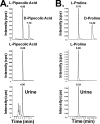Metabolomics reveals attenuation of the SLC6A20 kidney transporter in nonhuman primate and mouse models of type 2 diabetes mellitus
- PMID: 21487016
- PMCID: PMC3103330
- DOI: 10.1074/jbc.M111.221739
Metabolomics reveals attenuation of the SLC6A20 kidney transporter in nonhuman primate and mouse models of type 2 diabetes mellitus
Abstract
To enhance understanding of the metabolic indicators of type 2 diabetes mellitus (T2DM) disease pathogenesis and progression, the urinary metabolomes of well characterized rhesus macaques (normal or spontaneously and naturally diabetic) were examined. High-resolution ultra-performance liquid chromatography coupled with the accurate mass determination of time-of-flight mass spectrometry was used to analyze spot urine samples from normal (n = 10) and T2DM (n = 11) male monkeys. The machine-learning algorithm random forests classified urine samples as either from normal or T2DM monkeys. The metabolites important for developing the classifier were further examined for their biological significance. Random forests models had a misclassification error of less than 5%. Metabolites were identified based on accurate masses (<10 ppm) and confirmed by tandem mass spectrometry of authentic compounds. Urinary compounds significantly increased (p < 0.05) in the T2DM when compared with the normal group included glycine betaine (9-fold), citric acid (2.8-fold), kynurenic acid (1.8-fold), glucose (68-fold), and pipecolic acid (6.5-fold). When compared with the conventional definition of T2DM, the metabolites were also useful in defining the T2DM condition, and the urinary elevations in glycine betaine and pipecolic acid (as well as proline) indicated defective re-absorption in the kidney proximal tubules by SLC6A20, a Na(+)-dependent transporter. The mRNA levels of SLC6A20 were significantly reduced in the kidneys of monkeys with T2DM. These observations were validated in the db/db mouse model of T2DM. This study provides convincing evidence of the power of metabolomics for identifying functional changes at many levels in the omics pipeline.
Figures








Similar articles
-
UHPLC-MS-Based Serum and Urine Metabolomics Reveals the Anti-Diabetic Mechanism of Ginsenoside Re in Type 2 Diabetic Rats.Molecules. 2021 Nov 3;26(21):6657. doi: 10.3390/molecules26216657. Molecules. 2021. PMID: 34771066 Free PMC article.
-
Small intestine proteomics coupled with serum metabolomics reveal disruption of amino acid metabolism in Chinese hamsters with type 2 diabetes mellitus.J Proteomics. 2020 Jul 15;223:103823. doi: 10.1016/j.jprot.2020.103823. Epub 2020 May 16. J Proteomics. 2020. PMID: 32428569
-
Network pharmacology and metabolomics study on the intervention of traditional Chinese medicine Huanglian Decoction in rats with type 2 diabetes mellitus.J Ethnopharmacol. 2020 Aug 10;258:112842. doi: 10.1016/j.jep.2020.112842. Epub 2020 Apr 22. J Ethnopharmacol. 2020. PMID: 32333952
-
Importance of sulfur-containing metabolites in discriminating fecal extracts between normal and type-2 diabetic mice.J Proteome Res. 2014 Oct 3;13(10):4220-31. doi: 10.1021/pr500046b. Epub 2014 Sep 2. J Proteome Res. 2014. PMID: 24991707
-
Integrated biomarker for type 2 diabetes mellitus and impaired fasting glucose based on metabolomics analysis using ultra-high performance liquid chromatography quadrupole-Orbitrap high-resolution accurate mass spectrometry.Rapid Commun Mass Spectrom. 2020 Jun 30;34(12):e8779. doi: 10.1002/rcm.8779. Rapid Commun Mass Spectrom. 2020. PMID: 32159245
Cited by
-
Hypertensive rats show increased renal excretion and decreased tissue concentrations of glycine betaine, a protective osmolyte with diuretic properties.PLoS One. 2024 Jan 2;19(1):e0294926. doi: 10.1371/journal.pone.0294926. eCollection 2024. PLoS One. 2024. PMID: 38166023 Free PMC article.
-
Untargeted metabolomics of colonic digests reveals kynurenine pathway metabolites, dityrosine and 3-dehydroxycarnitine as red versus white meat discriminating metabolites.Sci Rep. 2017 Feb 14;7:42514. doi: 10.1038/srep42514. Sci Rep. 2017. PMID: 28195169 Free PMC article.
-
Novel Activity of Oral Hypoglycemic Agents Linked with Decreased Formation of Tryptophan Metabolite, Kynurenic Acid.Life (Basel). 2024 Jan 15;14(1):127. doi: 10.3390/life14010127. Life (Basel). 2024. PMID: 38255742 Free PMC article.
-
Metabolomics reveals an essential role for peroxisome proliferator-activated receptor α in bile acid homeostasis.J Lipid Res. 2012 Aug;53(8):1625-35. doi: 10.1194/jlr.M027433. Epub 2012 Jun 4. J Lipid Res. 2012. PMID: 22665165 Free PMC article.
-
Kynurenines and vitamin B6: link between diabetes and depression.J Bioinform Diabetes. 2013 Sep 14;1(1):http://openaccesspub.org/journals/download.php?file=51-OAP-JBD-IssuePDF.pdf. doi: 10.14302/issn.2374-9431.jbd-13-218. J Bioinform Diabetes. 2013. PMID: 25401165 Free PMC article.
References
Publication types
MeSH terms
Substances
Grants and funding
LinkOut - more resources
Full Text Sources
Other Literature Sources
Medical
Miscellaneous

